Training your cat to walk on a harness is a rewarding experience that does wonders for your feline’s mental stimulation and physical health. (1)
As a caring pet owner, you know that safety is paramount, and a cat’s harness offers a secure way to explore the outdoors with your furry companion. (2)
It’s a fantastic means to enrich your cat’s life with the wonders outside, from the new scents to the stimulating sights.
But before embarking on this exciting journey, selecting the appropriate harness and getting your cat accustomed to it are essential steps.
So, how to put on a cat harness?
Stay on top of your cat harness training with these tips – start slow and give your cat plenty of time to get comfortable. A little praise (and some treats) can go a long way.
Make sure your cat’s harness is correctly attached and always supervise your cat while they’re wearing a harness.
Since outdoor time with a harness may be overwhelming for some cats, they might resist or even slip out of their protective gear.
Harness training your cat is a great way to let them safely explore beyond the great indoors and get the exercise and stimulation they need.

Putting on a cat harness doesn’t have to be a struggle. It’s a process that, when done patiently and correctly, can be a smooth and even bonding experience between you and your pet.
A proper fitting is crucial for ensuring your cat’s comfort and security, and familiarity with the harness can prevent any anxiety or resistance.
With a little patience and following a step-by-step guide, you can easily maneuver the harness onto your cat without any fuss, and even turn it into a positive experience with treats and playtime.
Key Takeaways
- A harness offers a safe way to explore the outdoors and enrich your cat’s experiences.
- Proper selection and acclimation to the harness are essential for a comfortable fit.
- A patient approach to putting on the harness can create a stress-free experience for your pet.
Choosing the Right Harness
When you’re on the hunt for the perfect cat harness, comfort and safety should be your top priorities. Ever tried wearing jeans that are a size too small?
Yep, your cat will feel just the same in a harness that doesn’t fit. Let’s make sure we get it right by choosing a harness that fits your cat’s neck and body shape, including the cat’s neck.
Here are some cozy and secure options to consider:
- Material: Look for soft, breathable fabrics like mesh or lightweight nylon. They should feel comfy for your feline friend to wear and be durable for any of their nine lives’ worth of adventures.
- Size: Just as you wouldn’t wear a child’s t-shirt, getting the size right for your kitty’s harness is a must. Measure your cat’s neck and chest for a snug—yet not too tight—fit.
- Types of Harnesses:
- H-style: This traditional design is great for control and distributes pressure evenly.
- Vest: A secure choice that’s typically easier to escape-proof, providing extra coverage and support.
- Figure 8: A minimalist design that allows more freedom of movement but may require a patient kitty and a more experienced handler.
Now, how about a little shopping guide? Here’s what to look for:
- Read user reviews. These can give you insights into how true to size the harnesses are and their ease of use.
- Compare brands for durability. A harness that can keep up with your cat’s antics is a keeper.
- Check for breed-specific designs. Some harnesses are tailored for the unique body shapes of particular cat breeds.
Remember, every feline is one of a kind, and what works for your neighbor’s cat might be your kitty’s ultimate fashion faux pas. Happy harness hunting!
Preparing Your Cat for the Harness
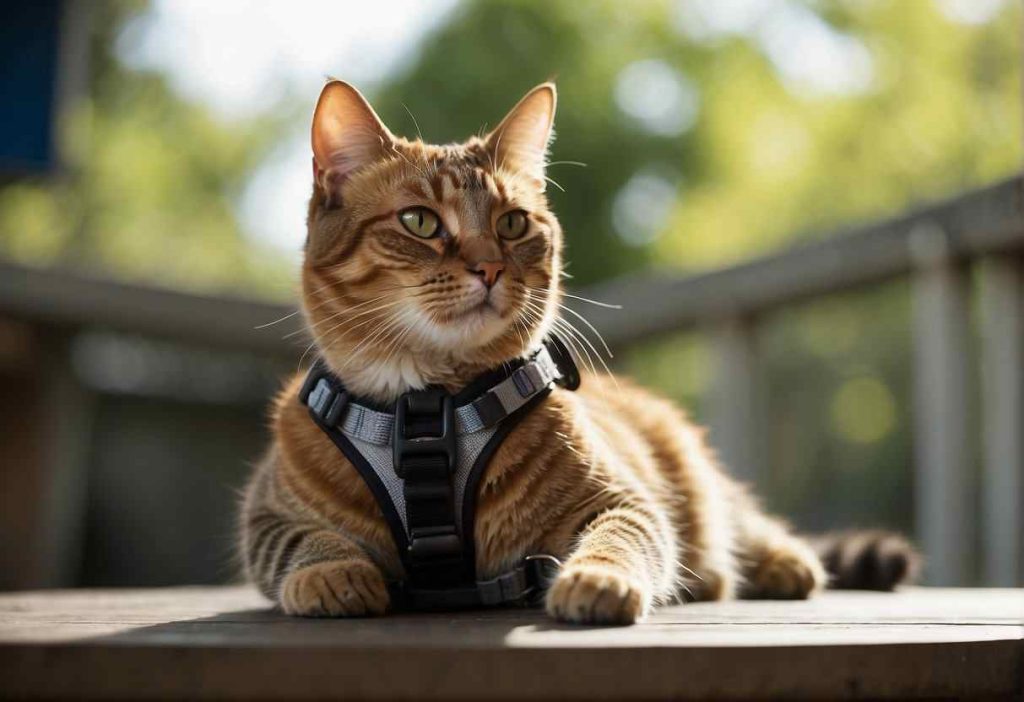
Getting your furball comfortable with a new cat harness can be quite the adventure! Begin in a safe space where your cat feels at ease.
It’s like introducing someone to a new type of cuisine — you don’t start with the spiciest dish!
Acclimatize Your Kitty:
- Start by letting your cat sniff the harness. Curiosity didn’t kill the cat; it made for a great intro!
- Place it near their favorite nap spot or feeding area to create a positive association. (3)
Positive Vibes Only:
- Treats are your best friend here. Who doesn’t love a good snack for being brave?
- Gradually increase the harness-wearing time from a few moments to several minutes, praising your cat and offering treats along the way.
Health and Safety First:
- Before venturing outside, consider microchipping your cat and possibly a GPS tracker for peace of mind. (4)
- Scan your environment for potential dangers and always keep an eye on interactions with other animals.
| Steps | Description |
| 1. | Allow sniffing of the harness in a comfortable environment. |
| 2. | Introduce treats and toys to create positive reinforcements. (5) |
| 3. | Gradually increase wearing time while offering rewards. |
| 4. | Prioritize health and safety with extra precautions like microchipping. (6) |
Remember, patience is key. Not every cat will strut their stuff in a harness on the first go, and that’s perfectly okay.
It’s like learning a dance; they might step on your toes a few times — metaphorically speaking, of course!
Be encouraging, and soon your whiskered companion will be ready to explore the great outdoors with confidence.
How to Put On a Cat Harness: Step-by-Step Guide

Fitting the Harness on Your Cat
Before we start, make sure your feline friend is calm and comfortable. Treats can help make this a positive experience!
H-Style Harness
- Lay the harness flat and identify the neck loop and girth loop.
- Place the neck loop over your cat’s head with the buckle resting on their back.
- Gently bring the girth loop around your cat’s stomach and fasten the buckles.
- Ensure the harness is snug but not too tight; you should be able to fit two fingers between the harness and your cat’s fur.
Vest Harness
- Preparation: Slide your cat’s head through the neck hole of the vest.
- Securing: Wrap the vest around the body, fastening the closures on the back.
- Adjustments: Tighten or loosen as needed for a ‘purr-fect’ fit, allowing for comfort and mobility.
Figure-8 Harness
- First, drape the harness over your cat’s neck, positioning the figure-8 across their shoulders.
- Next, cross the loops behind the front legs and secure the clips or fasteners.
- Check for an even fit, and adjust the sliders so that the harness sits snugly against your kitty’s body.
Adjusting the Harness for Comfort and Safety
- Correct Fit: The harness should be close-fitting but not too restrictive. Watch for any signs of discomfort or restriction of movement.
- Material Matters: Opt for a soft, breathable fabric to minimize the risk of chafing, especially if your cat has a short coat or is prone to skin irritation.
Always introduce the harness to your cat gradually, allowing them to smell and familiarize themselves with it.
Remember, patience is key – your kitty’s comfort and safety are most important during your outdoor adventures!
Training Your Cat to Walk with a Harness
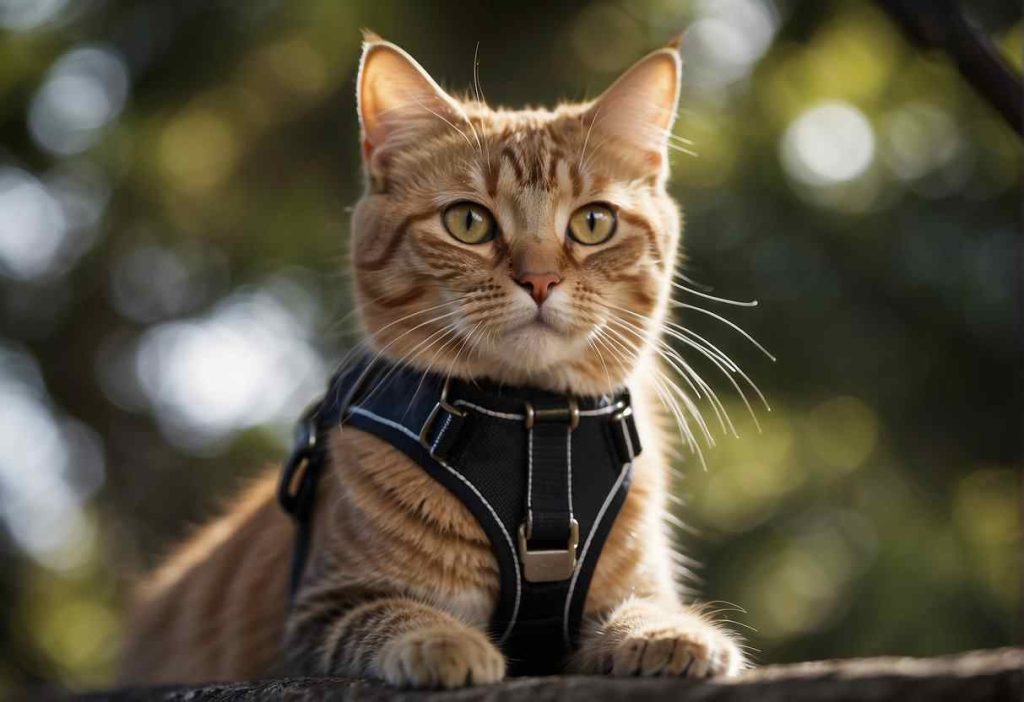
Gradual Introduction to Outdoor Walking
Take it slow. Start indoors where your cat feels secure. Here’s a quick guide on how to ease your fluffy friend into harness life:
- Harness Familiarization: Let your cat sniff and play with the harness. This builds positive associations.
- Dressing Time: Gently put the harness on your cat while offering treats. Keep initial sessions short, no more than a few minutes.
- Indoor Walkabouts: Allow your cat to leisurely roam around the house wearing the harness.
- Baby Steps Outside Once comfy indoors, venture to your yard or balcony for short expeditions.
Remember, you’re not climbing Mount Everest just yet. Keep initial outdoor trips brief and sweet.
Age-Specific Training Techniques
Different cats, different strategies. Here’s a quick breakdown:
- Kittens: They adapt quickly but ensure play time with the harness on to make it fun.
- Adult Cats: Patience is your best friend here. Older cats take longer to accept new gadgets.
- Senior Cats: Keep training sessions extra short and comfortable to suit their energy levels.
Remember Your Training Toolkit:
- Treats for positive reinforcement
- Toys to distract and engage
- Praise to build confidence
Lastly, be the guide your cat needs. Use gentle encouragement and never force them. You’ll find that training is not just about walking – it’s about bonding.
Ready to step out? Just imagine the Instagram photos! Keep at it, and before you know it, you and your cat will be exploring the great outdoors together. Happy walking!
Enhancing the Walking Experience
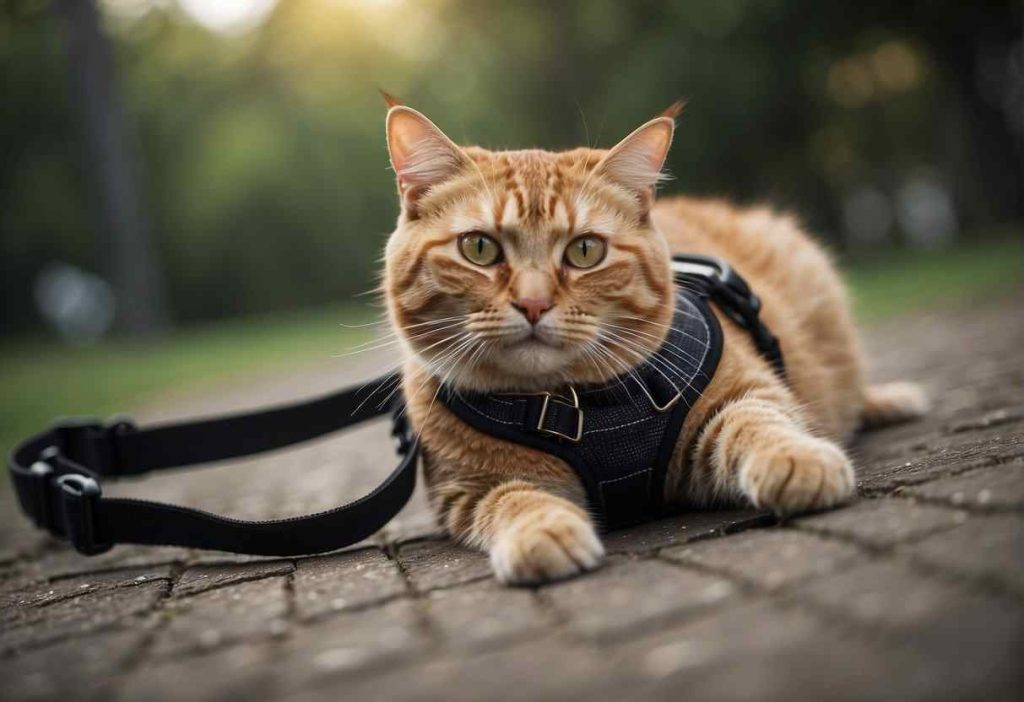
Taking your cat out for a walk isn’t just a stroll in the park; it’s about their physical and mental stimulation. Ever noticed how your feline friend perks up with wide-eyed wonder at the sight of a butterfly? Exactly!
Health and Behavior Insights
Your cat’s health gets a huge boost with regular harness walking. Think about it like this:
- Physical exercise: Helps maintain a healthy weight.
- Mental stimulation: All those outdoor sights and sounds? Brain food for your kitty!
Reading your cat’s body language is key:
- Tail up? That’s a happy cat.
- Ears back? This could mean they are overstimulated.
Advanced Tips and Outdoor Activities
Consider spicing up your outdoor adventures:
- Hide and seek with treats
- Exploration trips: New parks can be exciting to discover together.
When traveling, a harness can:
- Keep your cat secure in unfamiliar environments.
Here’s a table for quick reference:
| Behavior | Meaning |
| Purring and kneading | Contentment with surroundings |
| Hunkering down | Uncertainty or fear |
| Ears forward | Interest and alertness |
Remember, every cat is unique. So, what’s the plan? Start small, observe, and adapt. Whether it’s a short jaunt to the backyard or an adventurous hike, make every step with your kitty a memorable one!
Troubleshooting and Overcoming Challenges
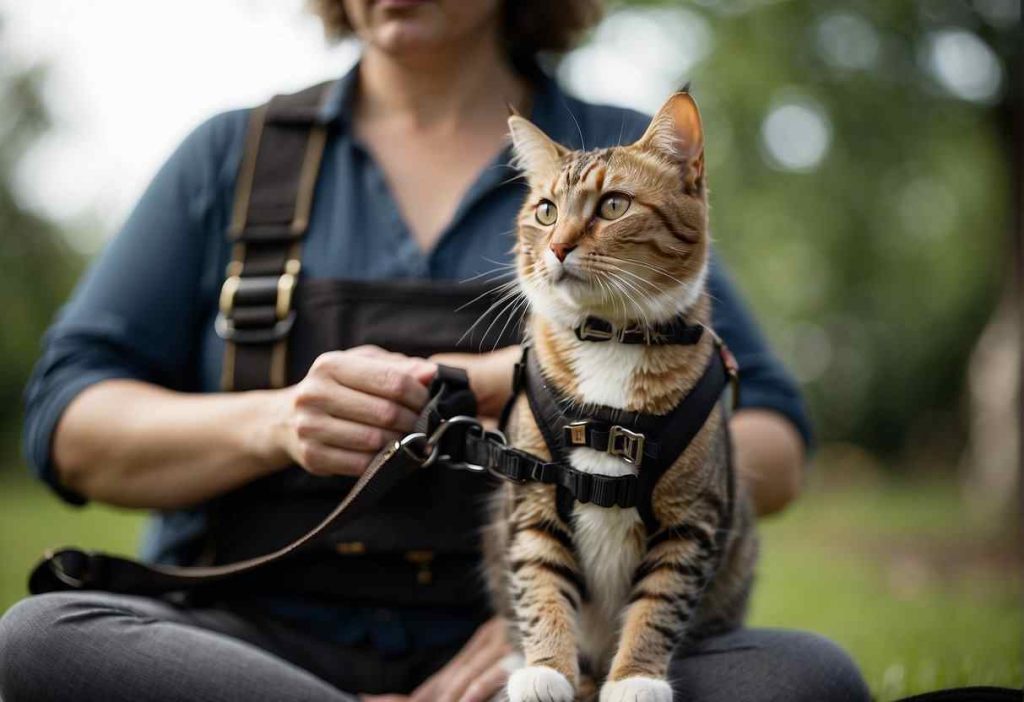
Encountering a stubborn kitty who just won’t budge in their new harness? You’re not alone, and it’s not a lost cause.
Overcoming the initial challenges of harness training can lead to fabulous outdoor adventures with your feline friend. Here’s a quick guide to help you through common hiccups:
Refusal to Move: Cats are creatures of comfort and a harness can seem pretty weird to them. When starting:
- Start slow: Introduce the harness during playtime, adding treats as positive reinforcement.
- Short sessions: Keep the initial harness-wearing sessions brief. Increase the time as your cat gets comfortable.
Fear of the Outdoors: The great outdoors can be daunting for an indoor cat.
- Safety first: Always start in a secure environment like a fenced yard.
- Familiarization: Allow your cat to explore just outside the door, gradually increasing adventure zones.
Real-Life Success Stories:
- Rosie’s owner coaxed her with treats and short walks. Now, Rosie can’t wait for her harness and the next big adventure outside.
Expert Tips:
- A snug fit is crucial. You should be able to fit two fingers under the harness.
- Desensitization is key. Use your cat’s favorite toys to distract them while putting on the harness.
Addressing Specific Challenges:
| Problem | Solution |
| Too tight | Adjust straps for comfort, checking at the neck and chest |
| Houdini cat | Ensure the harness is escape-proof with a proper fit |
Remember, patience is paramount. Each cat is unique and may take their own sweet time to accept the harness. Celebrate small wins and keep those treats handy!
Expert Contributions and Veterinary Advice

When you’re venturing into the world of cat harnesses, who better to guide you than the professionals?
Let’s tap into the wealth of knowledge from veterinarians and cat behaviorists to make this adventure as smooth as possible for you and your furry friend.
Choosing the Harness
Veterinary advice is clear: the fit and style of the harness are paramount. Dr. Vitale suggests starting with one that’s a breeze to put on—think H-harness or Figure Eight.
The goal is to find a harness that your cat is comfortable moving in, without it being too tight or too loose.
When choosing a harness, make sure to pay attention to the size and fit of the small loop, as this will go over your cat’s head and should not be too tight or too loose.
Additionally, consider the fastening mechanism of the harness, such as clips or velcro, to ensure it is secure and easy to use.
Positive Reinforcement
Experts in feline behavior stress the importance of creating a positive experience. That means using a sprinkle of their favorite treats and the allure of toys to forge positive associations.
Remember, patience is your best ally here!
Gradual Introduction
- Day 1: Let your cat sniff the harness
- Day 2-3: Gently drape it over them
- Day 4-7: Fasten it for a few seconds, then increase gradually
Spotting Stress Signals
Your cat’s body language is a tattletale. Watch for signs of stress:
- Flattened ears
- Tail tucked away
- Hiding or vocalizing
If you notice these, it’s time for a cuddle break!
Consistent and Kind
Always offer a gentle touch and an encouraging voice. Practice makes perfect, so keep the sessions short and sweet until your cat seems like a natural.
Remember: No need to rush. This journey is about trust, safety, and comfort—for both of you!
Quick Recap

Ready to transform your cat into a feline explorer? Here’s the cheat sheet to strap on that harness with confidence:
Getting Started:
- Choose the Harness: Pick either a Figure Eight or an H-harness, as these are the most common and quite cat-friendly.
- Measure Up: Ensure it fits snugly but doesn’t squeeze. You want your buddy to breathe easy, not feel the squeeze!
The Steps:
- Introduce the Harness: Let your cat sniff it, make it a toy, perhaps.
- Place the Harness: Slowly put the smaller loop of a figure eight harness over the head, or follow your H-harness instructions.
- Adjust the Fit: Strap in at the chest and belly, if needed. Confirm two fingers can slip under the straps.
- Safety Check: No twists or strains? No tight tugging on their fur? Great!
- Outdoor Intro: Start in a safe, enclosed space. Small steps!
Remember:
- Be patient. Rushing might equal scratching.
Consider Further Reading for insight into your cat’s body language to ensure they’re comfortable. For those curious minds, detailed guides and videos from Preventive Vet and Rover.com are gold. Prowling for top-tier harnesses? Scour Daily Paws for product reviews.
Beyond the Basics:
- Cats have personalities; find what harness suits yours.
- Increase the outdoor time gradually.
- Positive reinforcement? Always a treat. Literally.
Need more? Expert Advice is a click away on reputable cat care websites, and loads of Recommendations for Cat Behavior can teach you the ropes of feline persuasion.
Now, with harness in hand and a whisker-twitch of courage, you’re ready to walk on the wild… well, backyard. Happy adventuring!
Frequently Asked Questions
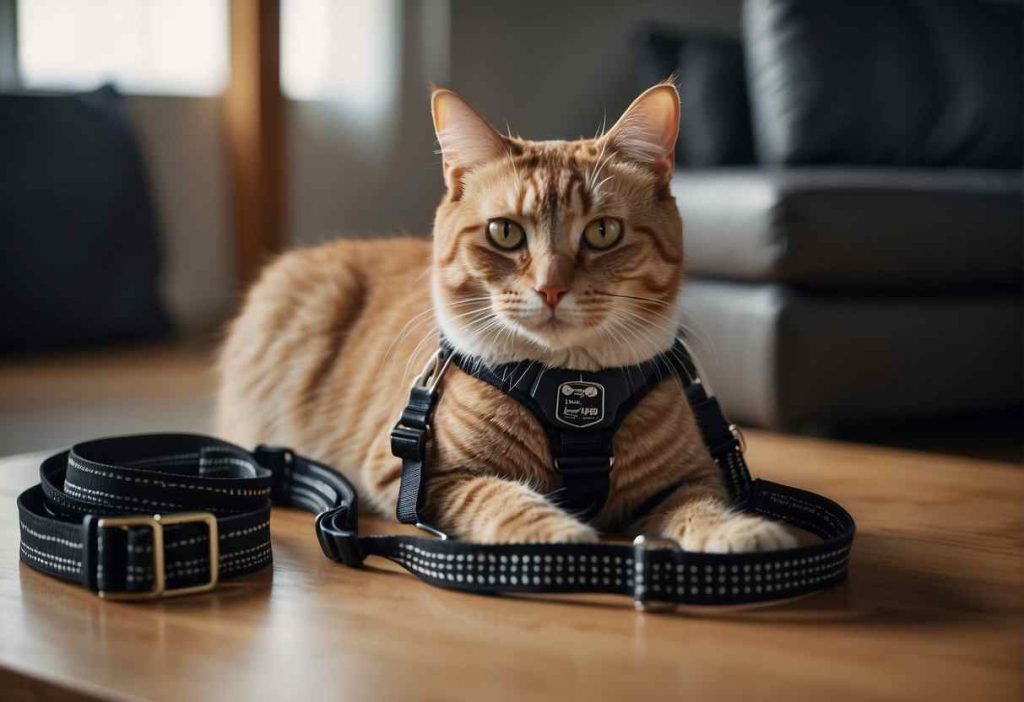
When dealing with cat harnesses, it’s essential to focus on a proper fit, appropriate style, and your cat’s comfort level to ensure a positive experience. Let’s address some common concerns you might have.
How do I know if the cat harness is the right fit for my cat?
Your cat’s harness should fit snugly without being too tight. You should be able to fit two fingers between the harness and your cat’s body.
Measure around your cat’s neck and chest and compare it with the manufacturer’s size guide to find the perfect size.
Can I leave the harness on my cat all day?
No, you shouldn’t leave the harness on all day. Prolonged wear can lead to skin irritations and matting of fur. It’s best to remove the harness after use.
What type of harness is best for a kitten?
For a kitten, a lightweight, adjustable harness is ideal. As kittens are still growing, adjustability allows for a proper fit as they grow.
A soft vest harness can provide added comfort and support for their small bodies.
How do I introduce my cat to a harness for the first time?
Start slowly by letting your cat sniff the harness. Next, drape it over them without fastening it, offering treats and praise.
Gradually increase the duration of the harness being on, always associating it with positive experiences.
What should I do if my cat refuses to move while in the harness?
If your cat freezes up, don’t force it. Remove the harness and try again later. Use treats and toys to encourage movement and create a positive association with the harness.
Is it safe to take my indoor cat outside with a harness?
Yes, it’s safe as long as the harness fits well and you remain attentive. Always supervise your cat and make sure the harness is secure before heading out.
How can I tell if my cat is comfortable in their harness?
Observe your cat’s behavior. A comfortable cat will walk, sit, and play while wearing the harness.
Any sign of discomfort, like scratching at the harness or trying to wriggle out, means it might not be the right fit or style.


